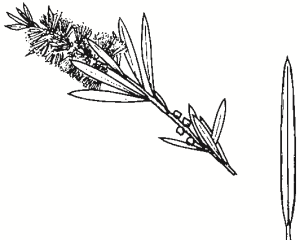Family:
Myrtaceae
Callistemon sieberi
River Bottlebrush
(syn. C. paludosus)
Other Names:

Name Origin:
sieberi — after F.W. Sieber (1789-1844), botanist from collected extensively in Australia.
Regional Subspecies:
Occurrence:
Regional:
Common along major creeks and rivers throughout region.
Australia:
Qld, NSW, Vic, SA.
Habitat:
Along watercourses, dried and rocky riverbeds and gullies.
Habit:
Shrub or small tree 2-7 m high. Pinkish new growth and narrow leaves 2-5 cm long.
Site Preference:
Moist soils. Tolerates severe seasonal waterlogging and inundation, poor and acidic soils, poor drainage, dry periods, frost, wind and fire.
Characteristics:
Fast-growing, hardy and adaptable.
Flowering:
Cream or pale yellow, rarely pink, mostly Nov-Jan.
Seed Collection:
Dec-Jan, as seeds shed after maturity. Collect from older wood.
Propagation:
From seed (± 300 viable seeds per gram) using the Bog method, or cuttings taken from firm young growth. Cuttings often difficult to strike. Mist and bottom heat may enhance strike rate.
Regeneration:
From seed, on sand and gravel banks after floods, and in absence of weed competition. After fire from seed, stem and coppice.
VALUES:
Shade & Shelter:
Useful low-level cover in windbreaks.
Land Protection:
Useful for stabilising streambanks due to soil-binding fibrous roots. Branches produce roots when in contact with moist soil.
Wildlife:
Important stream-side vegetation, for shade and insect source for fish. Flowers are a nectar source for honeyeaters and silvereyes, moths, butterflies and other insects. Foliage good refuge for small birds. Attracts seed-eating birds.
First Nations:
Drink made from nectar.
Ornamental:
Useful for screening, hedges, pond edges and bog gardens. Absorbs moisture in boggy sites. Prune severely to prevent straggly growth. Remove old flowerheads to promote flowering and bushiness.
Other:
Nectar can be sucked from the flowers.
